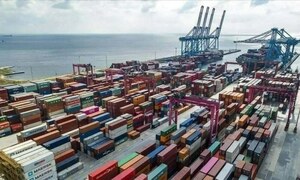The domestic cotton market continues to remain steady due to some interruption in seedcotton (Kapas/Phutti) supplies because of rains and swelling of rivers over the past several weeks. However, this phenomenon could now recede and supplies restored in the foreseeable future. The overall crop condition is still being described as being satisfactory.
It is now being estimated that the new crop (August 2015 / July 2016) could now be around 14.8 million bales (155 Kgs). As of now, 125 ginning factories are pressing the new crop. Daily arrivals have risen to nearly 25,000 domestic size bales. Till now seedcotton for about 1.2 million lint equivalent bales has already arrived into the factories. Daily turnover in the ready cotton market is said to be 25,000 bales. Yarn prices, however, are said to be doing not so well. The overall quality of cotton from both Sindh and Punjab is said to be alright.
Traders said that some seedcotton of low grade cotton is arriving in Sindh. Brokers said from Karachi that certain mills are interested in old crop (2014/2015) still lying with the Trading Corporation of Pakistan (TCP) but that their earlier tenders placed with the TCP were not accepted.
Seedcotton prices in Sindh were said to have ranged from Rs. 2450 to Rs.2550 per 40 Kgs, while in the Punjab they reportedly ranged from Rs. 2200 to Rs.2550 per 40 Kgs, according to the quality. Lint prices in Sindh were said to have ranged from Rs.4700 to Rs.4750 per maund (37.32 Kgs), while in the Punjab they also reportedly extended from Rs.4700 to Rs.4750 per maund.
International cotton prices were said to be well maintained over the past several days but have now said to have started to abate and consolidate. The firmness in international futures prices was said to have been sponsored by the speculators.
In Sindh cotton ready sales reported on Thursday, 1,000 bales of cotton each from Mirpurkhas and Sanghar were said to have materialised at Rs.4700 to Rs.4750 per maund (37.32 Kgs) in a steady market and as per quality. Also, 1,400 bales from Shahdadpur and 1,000 bales from Tando Adam sold at Rs. 4,750 per maund.
In ready cotton sales in Punjab, 200 bales of cotton from Bahawalnagar, 400 bales each from Burewala and Khanewal, and 600 bales from Chichwatni, all were said to have been sold at Rs.4750 per maund.
On the global economic and financial front, there is no silver living on the horizon. In fact, latest data emerging since the last couple of months clearly shows that the health of the global economy has gone from bad to bust. First it was the beginning of the Great Recession in 2008 when the global financial firm Lehman Brothers, the fourth largest investment bank in America filed for chapter 11 bankruptcy in September, 2008. Later, the economies of Spain, Portugal, Greece and other peripheral economies in the Eurozone started deteriorating irretrievably. In due course of time, the global economic and financial stagnation enveloped many if not most countries in the world so that today we stand close to a universal economic collapse which appears posed to surpass the global depression of 1929.
While the global economy continues to smoulder pitilessly, no amount of fiddling, now or later on, is likely to resurrect the economic fortunes in the foreseeable future. The entire economic model of growth needs revision. Moreover, the discredited global financial system does not merely need an overhaul, it needs to be replaced by a new dispensation of credible substance.
Over the recent past, it came to be believed that besides the capitalist system as in America, the United Kingdom and Western Europe and the BRICS countries would somehow retrieve the shaken economies of the world. However, that was not to be. Brazil and Russia are all shook up badly. Indeed the recent colossal collapse in the prices of sundry commodities has further undermined the global economy seriously. Crude oil prices are at six year low levels. No light is seen but rather darkness all around.
If we look at some of the global economies piecemeal, there hardly appears any scope for an early revival. Besides pure economic reasons, political considerations like the onslaught of refugees fleeing North Africa and the Middle East into the core countries of Europe is a disaster in the making.
Starting at midweek and continuing on Thursday, equity prices fell dramatically in the United States, China, Asia and Europe enveloping almost all the globe, despite Federal Reserve interest rate having being cut to near zero since December, 2008. Besides, several other countries like Japan, China and the Eurozone have also kept their interest rates at very low levels.
As a result of all these developments, some analysts have started doubting the veracity of the economic data being delivered by the Chinese official agencies. Moreover, the recent Chinese devaluation jolted the entire region and spread nervousness in the markets. There are fears that a "currency war" could commence globally as each country would try to push its exports to compete with each other.
To recount, the Japanese economy viz. Abenomics has been slipping backwards since the last three months. Indeed Japan has been facing deflation since the past ten years. The Brazilian economy has collapsed as tens of thousands of its citizens are protesting vigorously. Thus share values are continuing to fall rather precipitously from America, Europe and China to the Middle East and Japan with little hopes of an early recovery.
BR100
11,824
Decreased By
-41.8 (-0.35%)
BR30
35,784
Increased By
87.2 (0.24%)
KSE100
113,431
Decreased By
-717.2 (-0.63%)
KSE30
35,701
Decreased By
-250.8 (-0.7%)

























Comments
Comments are closed.